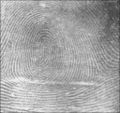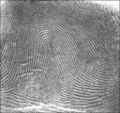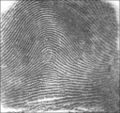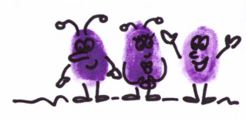Fabulous Forensic Fingerprints
| Instant wiki maker | Making handouts | Editing tips |
Contents
- 1 Fabulous Forensic Fingerprints
- 1.1 Student worthiness
- 1.2 Primary biological content area covered
- 1.3 Materials
- 1.4 Handouts
- 1.5 Description of activity
- 1.6 Lesson plan
- 1.7 Potential pitfalls
- 1.8 Math connections
- 1.9 Literature connections
- 1.10 Art Connections
- 1.11 Connections to educational standards
- 1.12 Next steps
- 1.13 Citations and links
Biology In Elementary Schools is a Saint Michael's College student project from a course that ran between 2007 and 2010 and fully described in this book chapter. The student-created resources have been preserved here for posterity. Link under 'toolbox' for printer-friendly versions of the exercises. Click on handouts to print full resolution versions. Please see Wikieducator's disclaimer, our safety statement, and the Creative Commons licensing in English and in legalese.
Fabulous Forensic Fingerprints
Student worthiness
Tried and Trusted.
Primary biological content area covered
Students will learn about the uniqueness of each person's individual body. To do this students will identify traits and characteristics of the human body, with a main focus on the uniqueness of fingerprints and footprints.
Materials
- Paper/Index cards
- Pencils and or loose graphite
- Clear Scotch Tape
- Magnifying Glasses
- Graph Paper
- Washable ink pad (optional)
- Ghostwriter Detective Guide : Tools and Tricks of the Trade by Susan Lurie and illustrated by Felipe Gallindo (optional)
Handouts
- Different fingerprint types
Description of activity
Students will examine and compare fingerprints. They will categorize their fingerprints, using the terminology: loops, arches and whorls. Students will use a bar graph form to display the results of their prints.
Lesson plan
- Students will place a piece of paper on a hard surface.
Using a pencil, they will scribble heavily in an area on the paper, creating a region of loose graphite on the paper.
- The students will press their right thumb into the graphite area on the paper (which was left by the pencil markings) until their thumbs are completely covered.
- Next, the students will press their thumbs on the sticky side of a piece of scotch tape. The students should then pull the tape off of their fingers, leaving a clear fingerprint on the tape. Have each student stick the tape with his or her fingerprint onto the handout provided.
- Repeat above directions for each finger on both hands.
- Have students decide which type of fingerprints they have. (The links at the bottom of the page give an in depth description of the various types of fingerprints) Record observations onto the handout provided. There are three possible categories:
- Loops (Left or Right)
- Whorls
- Arches
- Have the students compare and contrast their fingerprints with other students in the group.
- On large graph paper, use a bar graph to display the class findings based on what category of fingerprints everyone in the class has.
Potential pitfalls
It may be necessary to remind the children not to get the graphite all over their clothing. Students may have difficulty pulling their fingerprints from the pencil marks. If this is the case, advise them to apply more graphite to their fingers or use a different form of "ink". A type of washable ink would be preferable, however some inks are soy-based and could perhaps be a potential source of allergens.
After having done the experiment with the kids the problem arose that a student was allergic to soy so we were right about that being a potential problem. However besides that it went even better than we thought it would and the kids seemed to have a good time!
Math connections
- Students will learn how to present their findings on a graph and later analyze the information based on their own fingerprint data.
- The students will graph the classified fingerprints in the class. This will show how many students have loops on their fingers, arches, whorls or a combination of the three. They can then compare their findings and see what fingerprint pattern is the most common within their class.
Literature connections
- "Ghostwriter Detective Guide : Tools and Tricks of the Trade"
by Susan Lurie and illustrated by Felipe Gallindo
Art Connections
- Students can create fun pictures using their fingerprints. Materials needed are different colored washable ink pads, paper and pencils. Suggested images can be found at [Billy Bear's Playground]
Connections to educational standards
S:4 Students demonstrate their ability to conduct experiments (7.1 c; 7.2 c, d; 2.2 e, f, g ) Enduring Knowledge (Representing Data and Analysis): Students represent data using text, charts, tables, graphs.
Next steps
Another activity could be developed by touching glass beakers and brushing talcum powder on the beakers to see the fingerprints. This can then be related to law enforcement & forensics. To go further with this activity, a crime scene could be created, where students need to brush the talcum powder on whatever has been touched and then try to figure out who "committed the crime" by looking at the three different classifications of fingerprints & searching through the class fingerprints.
Citations and links
- http://pbskids.org/zoom/activities/sci/fingerprints.html
- http://www.fingerprintamerica.com/
- http://www.fbi.gov/hq/cjisd/takingfps.html
- http://en.wikipedia.org/wiki/Fingerprint
- http://www.billybear4kids.com/Learn2Draw/FingerPrints.html
- Vermont State Grade Expectations can be found at the State of Vermont Department of Education website.








